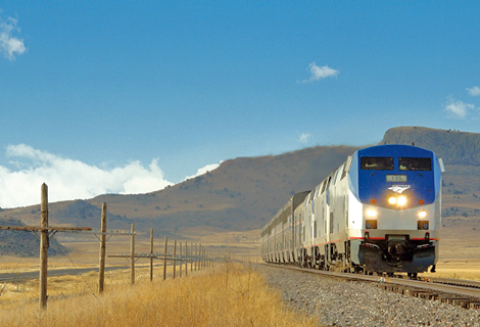After last week’s train derailment that killed 8 people and injured over 200, everyone is thinking about how to make trains safer. That’s a worthwhile goal, but trains are already a remarkably safe way to get around, especially when compared with America’s true love: cars. If Americans drove less and took trains more, it could mean thousands or even tens of thousands fewer sudden, violent deaths every year. Getting cars off the roads would help combat climate change and improve air quality as well. Government policy could make this happen.
Cars are really dangerous. If a highly-trained conductor can commit a fatal error guiding a train down a track, driver error among millions of untrained amateurs operating on a variety of roads with complex traffic patterns and no tracks is guaranteed. Car accidents kill around 30,000 Americans each year, enough to place them among the leading causes of death alongside flu, pneumonia, liver disease and suicide.

CREDIT: Andrew Breiner
The data bear that out. According to a report from Research in Transportation Economics, for every billion passenger miles traveled, cars killed 7.3 people. Trains killed only 0.43 people. Buses and planes were even better at 0.11 and 0.07 fatalities per billion miles traveled. To make things worse, car exhaust has been shown to contribute to leading health problems like heart disease, cancer, asthma, and diabetes. Add in 2.5 million non-fatal injuries a year from car crashes and their huge contribution to climate change, and it’s a wonder we’re not racing to get cars out of American life.
The federal government gives Amtrak about $1.4 billion dollars each year to keep it running and in good repair — just .003 percent of the federal budget. That’s on top of the $2.18 billion Amtrak makes in ticket revenue. Train travel opponents point to the government subsidy to say that most train travel is too inefficient – that private companies should take over, shut down most lines, and just keep the most lucrative Northeast corridor routes running.
Meanwhile, a report from the U.S. Public Interest Research Group found that taxpayers are paying $69 billion a year for highway construction and maintenance. And that’s just to maintain and expand an already extensive system. The federal government paid $119 billion to construct the interstate system starting in 1952, shouldering 90 percent of the cost of the project. That initial investment helped set the car up as the favorite method of transportation in the U.S., at the expense of all others.
In the same way that the U.S. subsidized cars, other countries are subsidizing trains. China is currently undertaking a huge public investment in rail. And while the system has experienced problems, ridership was nearly 900 million in 2014, compared to a paltry 30 million in the U.S. And the United Kingdom, with a far smaller area and population than the U.S., spends billions more than in public money to maintain its world-class system that regularly sees 1.2 billion passengers a year.

CREDIT: Andrew Breiner
The Washington Times blamed “a culture of financial irresponsibility and mismanagement” at Amtrak for last week’s crash, criticized it for never turning a profit, and for spending some of its money maintaining little-used routes outside of the high-volume Northeast corridor.
But what’s wrong with the government subsidizing rail in places where it’s not profitable? If a well-funded system could get people to take the train instead of drive in the south, the midwest, and California, the saved lives would surely be worth some federal spending. And a National Journal feature on train travel found that deep-red Mississippi had another argument for keeping its money-losing train lines: economic growth. “If we’re not linked together, we’re not going to be competitive in 15, 20 years,” one Mississippi physician and rail advocate told National Journal. Towns and cities are better-connected to the national and global economy when they’re on train lines.
The amount the U.S. spends on its trains is clearly linked to their quality and popularity. As the National Journal feature notes, The Sunset Limited, a Gulf Coast train service that hasn’t been restored since Hurricane Katrina, was a nightmare. It ran three times a week, and was only on time 4.5 percent of the time. No one would want to plan a trip around that.
Then there’s the effect more funding would have on safety. National Transportation Safety Board (NTSB) member Robert Sumwalt told reporters that a technology called positive train control (PTC), which was not installed on the portion of track where the Philadelphia crash occurred, would have prevented it. Multiple NTSB officials have said it’s the cost of the system, which is expected to be between $9.5 billion and $13.2 billion over 20 years, that led to the delay in its implementation. Considering the constant threat of budget cuts and the fact that Amtrak’s entire yearly budget is only $3.5 million, it’s no wonder the expensive safety system wasn’t immediately put in place.

CREDIT: Andrew Breiner
Even with stagnant funding making Amtrak less safe and reliable, ridership has been climbing. Americans are driving less each year, and each generation of young people has been less interested in driving and car ownership than the last. With an adequately funded system of trains, there’s no saying how many cars would get off the road.


Spread the word